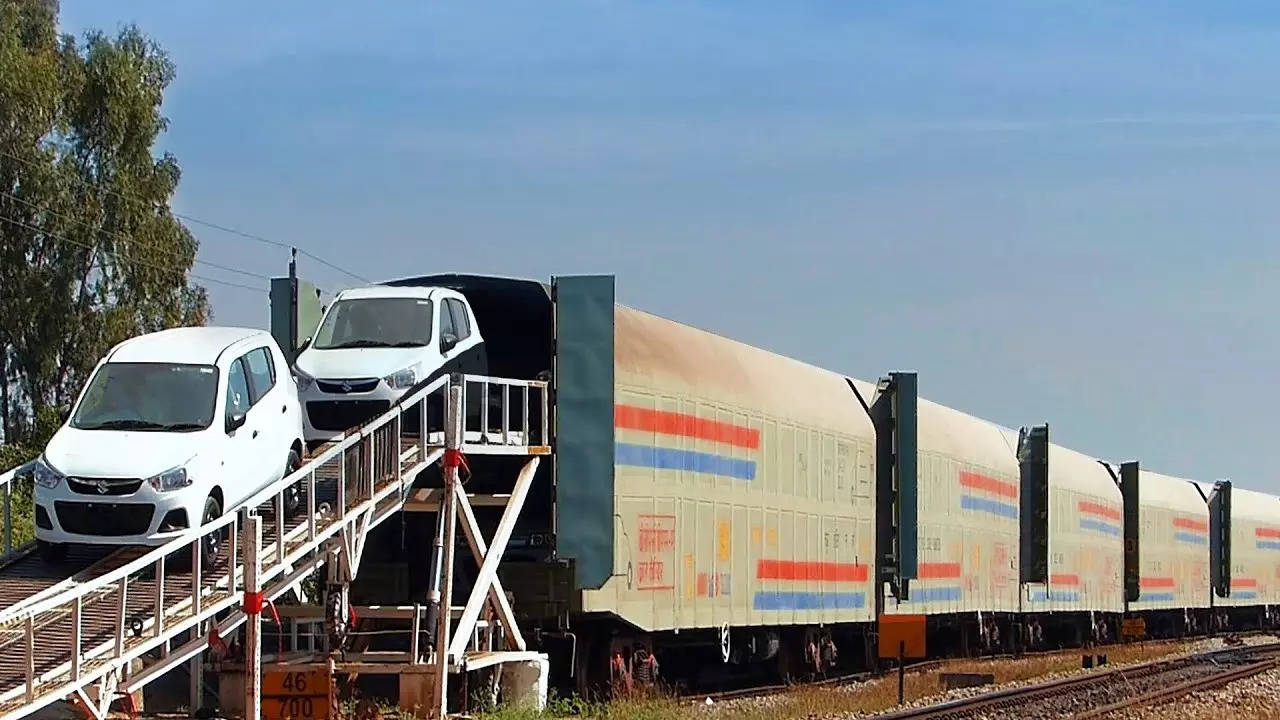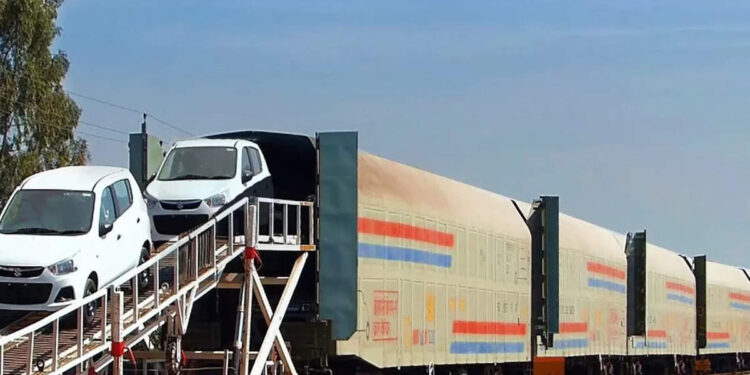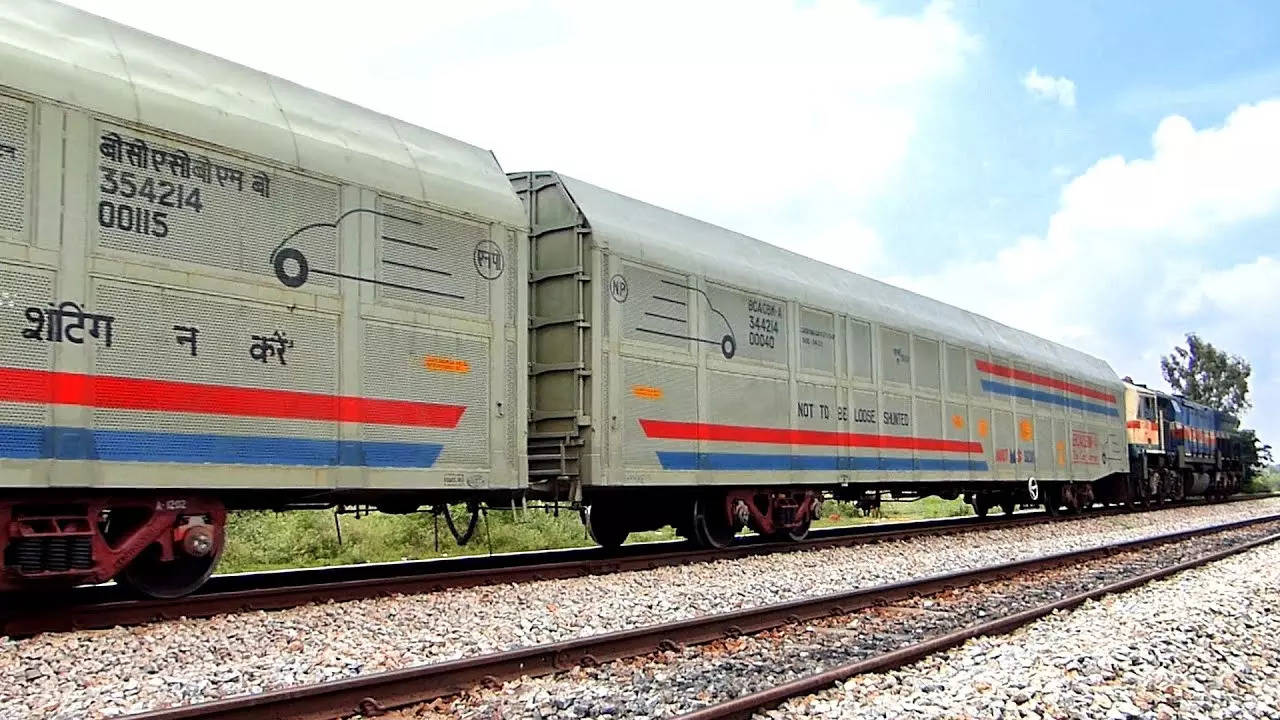
New Delhi: Road transport has traditionally been the dominant mode of transport to ferry the vehicles from the manufacturing hubs to market destinations in India due to its flexibility and accessibility. Gradually, automakers are shifting to railways to carry their vehicles from the factories to the dealerships mainly to cut logistics cost, meet sustainability targets and comply with emission norms. This also allows them to reduce the transit time, ferry larger volumes of vehicles in one go and ensure safety during transportation.The rail freight rates have remained stable for the past 10 years, which has been a major support for the industry. However, the Ministry of Railways has revised the rates of haulage charge, increased the freight rates by 20% for the movement of Bogie Covered Autorake Double Decker Wagon (BCACBM) from the current financial year.
“Automobile manufacturers have internal targets for utilization of railways and have been working towards achieving that. But with this rate revision, manufacturers may need to re-look at their targets and might shift their volumes to other modes of transportation,” Rajesh Menon, Director General, Society of Indian Automobile Manufacturers (SIAM) said.
“Automobile sector was not anticipating such a revision. Rather, a revision in a phased manner would have been more appropriate, year-on-year basis, for business planning,” he said.
Industry experts believe that such a rate revision has come up at a time when transportation via railway rakes was increasingly becoming a preferred mode. Such a revision in rates may serve as a dampener in its growth.
Bal Malkit Singh, Chairman- Core Committee & Former President, All India Motor Transport Congress (AIMTC) said that the 20% revision in rates signifies that the current freight structure is not viable in the light of rising operating costs.
Maruti leads the way
Maruti Suzuki was the first carmaker to use railways to transport its vehicles in the country. Over the past 8 years, the company has increased its rail dispatches by five-fold. In FY15, it transported 65,700 units which has now increased to 3,35,245 units in FY23. Cumulatively, it has dispatched over 14.9 lakh vehicles using the rail mode till FY23 and claims to have averted 6700 MT of carbon emissions.
Railway dispatches has also helped the automaker to reach its customers in Southern and North-Eastern states much faster. Maruti Suzuki has 40 railway rakes, with a capacity to carry over 300 vehicles per rake. It utilizes 7 loading terminals across Delhi-NCR and Gujarat and 18 destination terminals – Bangalore, Nagpur, Mumbai, Guwahati, Mundra Port, Indore, Kolkata, Chennai, Hyderabad, Ahmedabad, Delhi-NCR, Siliguri, Coimbatore, Pune, Agartala, Silchar, Ranchi and Ludhiana.
Rahul Bharti, Executive Officer- Corporate Affairs, Maruti Suzuki said that for the decongestion of roads, achieving higher energy efficiencies and for reducing CO2 emissions, it is important to increase railways transportation.
However, he added, “For railway logistics to be viable, the cost of logistics must be lucrative and competitive. We are hoping that as the volume of railway dispatches increase, economies of scale will set in.”
Going forward, the maker of WagonR and Swift is bullish on railway transportation and said that it is targeting to systematically increase dispatches by close to about 1 lakh units annually in the coming years.
Industry experts believe that railways still need to cater to the potential of a major portion of automakers’ production for transportation.
Transporting vehicles via Railways vs Roadways
Industry experts suggest that for short distances there is not much difference in the cost of transportation via different modes. However, for long haul the cost of transportation by road is almost double when compared of railways.
Chetak Group, which has been in the logistics industry for over four decades, is also looking to venture into railways as a mode of vehicle transportation. The company caters to auto OEMs including Maruti Suzuki, Hyundai, JCB, Kia, Honda, among others.
Sachin JKS Haritash, Director, Chetak Logistics said, “We are planning to invest in railways. We will finalize and place an order for bogies by this year.” One railway bogie, which can carry about 300 cars, costs about INR 25 crore.
According to SIAM estimates, for transporting a mid-size car over a distance of 2,200 kms today, the cost of transporting vehicles by road is about INR 30,000. For transporting the same vehicle through railways the cost comes up to around INR 20,000.
Apart from lowering the carbon footprint, one of the biggest reasons for shifting to railways has been a significant increase in the cost of transportation of vehicles by road over the past 10 years. While this increase and the overall cost of transportation varies from one manufacturer to another, it is largely dependent on the volume of vehicles being transported and the long-term rate agreements vehicle manufacturers may have with their logistics providers.
It may also be noted that while transporting vehicles via railways, additional first and last mile expenses are also borne by the vehicle manufacturers, Menon said. For transportation via railways, OEMs move the vehicle from the manufacturing plant to the nearest railway yard where cars are loaded in the rakes. It is then transported from the start point of the rail route to its end. This is followed by carrying it to the respective dealerships.
For railways, the automakers also need to cater to the cost of terminal handling.
Singh of AIMTC stated that unlike railways, roadways provide the flexibility of first and last mile delivery. Road transporter trucks also provide an advantage of operating as per the client’s schedule. To ensure safety, covered car carriers put a physical shell around the vehicle during transit. The transporter trucks are also designed specifically to carry cars and are equipped with loading lifts, winches, ramps and also come with secure mounting points for the vehicle.
In 2018, the government relaxed the Policy and reduced the registration fee to INR 3 crore from INR 5 crore earlier. The number of rakes to be procured which stood at 3 was also reduced to 1 and restrictions to transport the automobiles in a single direction were lifted.
Maruti Suzuki is the only SIAM member which has an AFTO license. This license allows the Company to fabricate and operate high speed, high capacity auto wagon rakes on the Indian Railways network. In addition, there are other private operators like the Transport Corporation of India, APL Vascor, IVC Logistics, amongst others who have obtained the license for transporting vehicles via railways.
Earlier, the Indian Railways also developed the New Modified Goods (NMG) rakes, which are largely passenger wagons adjusted in a manner where windows are welded and passenger seats are removed. The vehicles are then loaded from the rear in the empty capsule-like structure.
Currently, the NMG and the BCACBM Auto Loader wagons are used for vehicle transportation via railways.


















